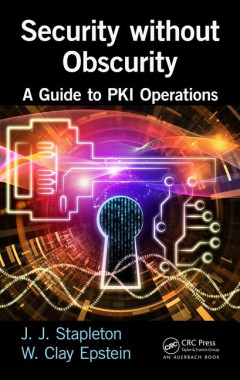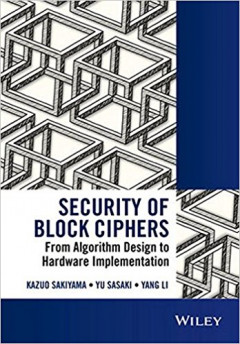Filter by

Security without obscurity a guide to PKI operations
Contents 1 Introduction 2 Cryptography basics 3 PKI building blocks 4 PKI management and security 5 PKI roles and responsibilities 6 Security considerations 7 Operational considerations 8 Incident management 9 PKI governance, risk, and compliance 10 Advanced PKI
- Edition
- --
- ISBN/ISSN
- 9781498707473
- Collation
- xv, 343 hal.; ilus.; 24 cm
- Series Title
- --
- Call Number
- 005.82 STA s

PHP advanced and object-oriented programming
Table of Contents Chapter 1 Advanced PHP techniques Chapter 2 Developing web applications Chapter 3 Advanced database concepts Chapter 4 Basic object-oriented programming Chapter 5 Advanced OOP Chapter 6 More advanced OOP Chapter 7 Design patterns Chapter 8 Using existing classes Chapter 9 Example-CMS with OOP Chapter 10 Networking with PHP Chapter 11 PHP and the server Chapter 12…
- Edition
- --
- ISBN/ISSN
- 9780321832184
- Collation
- xii, 492 hal.; ilus.; 23 cm
- Series Title
- Visual quickpro guide
- Call Number
- 005.262 ULL p

Steganography Forensic: metadata analysis for steganography detection
Contents Chapter 1 Indroduction Chapter 2 Literature background on steganography Chapter 3 Research methodology Chapter 4 Steganography samples Chapter 5 Steganalysis approach for steganography detection Chapter 6 Metadata analysis approach for steganography detection Chapter 7 Conclusions Chapter 8 Recommendations for further work
- Edition
- --
- ISBN/ISSN
- 9783330004597
- Collation
- ix, 136 hal.; ilus.; 22 cm
- Series Title
- --
- Call Number
- 005.82 AL- s

Security of block ciphers: from algorithm design to hardware implementation
Contents 1 Introduction to block ciphers 2 Introduction to digital circuits 3 Handware implementation for block ciphers 4 Cryptanalysis on block ciphers 5 Side-channel analysis and fault analysis on block ciphers 6 Advanced fault analysis with techniques from cryptanalysis 7 Countermeasures against side-channel analysis and fault analysis
- Edition
- --
- ISBN/ISSN
- 9781118660010
- Collation
- ix, 295 hal.; ilus.; 25 cm
- Series Title
- --
- Call Number
- 005.82 KAZ s

Bluetooth security attacks: comparative analysis, attacks, and countermeasures
Table of contents: 1.Introduction 2.Overview of Bluetooth Security 3.Reasons for Bluetooth Network Vulnerabilities 3.1.Vulnerability to Eavesdropping 3.2.Weaknesses in Encryption Mechanisms 3.3.Weaknesses in PIN Code Selection 3.4.Weaknesses in Association Models of SSP 3.5.Weaknesses in Device Configuration 4.Comparative Analysis of Bluetooth Security Attacks 4.1.Disclosure Threats …
- Edition
- --
- ISBN/ISSN
- 9783642406454
- Collation
- 93 hal.; ilus.; 24 cm
- Series Title
- --
- Call Number
- 004.6 HAA b

New stream cipher designs: the eSTREAM finalists
Table of contents: 1. The eSTREAM Project 2. CryptMT3 Stream Cipher 3. The Dragon Stream Cipher: Design, Analysis, and Implementation Issues 4. The Stream Cipher HC-128 5. Design of a New Stream Cipher—LEX 6. Specification for NLSv2 7. The Rabbit Stream Cipher 8. The Salsa20 Family of Stream Ciphers 9. Sosemanuk, a Fast Software-Oriented Stream Cipher 10. eSTREAM Software Performanc…
- Edition
- --
- ISBN/ISSN
- 9783540683506
- Collation
- viii, 293 hal.; ilus.; 24 cm
- Series Title
- --
- Call Number
- 005.82 ROB n

Protocols for authentication and key establishment
Table of contents: 1. A Tutorial Introduction to Authentication and Key Establishment 2. Goals for Authentication and Key Establishment 3. Protocols Using Shared Key Cryptography 4. Authentication and Key Transport Using Public Key Cryptography 5. Key Agreement Protocols 6. Conference Key Protocols 7. Password-Based Protocols A. Standards for Authentication and Key Establishment B. Sum…
- Edition
- --
- ISBN/ISSN
- 9783642077166
- Collation
- xxiv, 320 hal.; ilus.; 24 cm
- Series Title
- --
- Call Number
- 005.8 BOY p

Virtualization and forensics: a digital forensic investigator's guide to virt…
Table of contents: 1. How virtualization happens 2. Server virtualization 3. Desktop virtualization 4. Portable virtualization, emulators, and appliances 5. Investigation dead virtual environments 6. Investigating live virtual environments 7. Finding and imaging virtual environments 8. Virtual environments and compliance 9. Virtualization challenges 10. Cloud computing and the forensi…
- Edition
- --
- ISBN/ISSN
- 9781597495578
- Collation
- xvii, 253 hal.; ilus.; 24 cm
- Series Title
- --
- Call Number
- 005.8 BAR v
Network forensics: tracking hackers through cyberspace
Table of contents: Part I: Foundation Chapter 1: Practical Investigative Strategies Chapter 2: Technical Fundamentals Chapter 3: Evidence Acquisition Part II: Traffic Analysis Chapter 4: Packet Analysis Chapter 5: Statistical Flow Analysis Chapter 6: Wireless: Network Forensics Unplugged Chapter 7: Network Intrusion Detection and Analysis Part III: Network Devices and Servers…
- Edition
- --
- ISBN/ISSN
- 9780132564717
- Collation
- xxvi, 545 hal.; ilus.; 24 cm
- Series Title
- --
- Call Number
- 005.8 DAV n

Homomorphic encryption and applications
1.Introduction 1.1.Classical Ciphers 1.2.Secret Key Encryption 1.3.Public-Key Encryption 2.Homomorphic Encryption 2.1.Homomorphic Encryption Definition 2.2.Goldwasser-Micali Encryption Scheme 2.3.ElGamal Encryption Scheme 2.4.Paillier Encryption Scheme 2.5.Boneh-Goh-Nissim Encryption Scheme 3.Fully Homomorphic Encryption 3.1.Fully Homomorphic Encryption Definition 3.2.Overview o…
- Edition
- --
- ISBN/ISSN
- 9783319122281
- Collation
- xii, 126 hal.; ilus.; 24 cm
- Series Title
- --
- Call Number
- 005.82 XUN h
 Computer Science, Information & General Works
Computer Science, Information & General Works  Philosophy & Psychology
Philosophy & Psychology  Religion
Religion  Social Sciences
Social Sciences  Language
Language  Pure Science
Pure Science  Applied Sciences
Applied Sciences  Art & Recreation
Art & Recreation  Literature
Literature  History & Geography
History & Geography